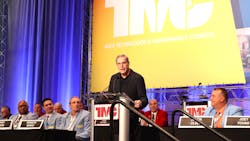ATA’s Spear calls out 'unrealistic' trucking emissions timelines
ORLANDO, Florida—The leader of American Trucking Associations has called on the industry to stand up as one to government agencies against what he called "unrealistic" environmental regulation timelines.
During ATA’s Technology & Maintenance Council 2023 Annual Meeting here at the Orange County Convention Center, Chris Spear, ATA's president and CEO, criticized the more stringent trucking emissions deadlines that the California Air Resources Board and U.S. Environmental Protection Agency have put on the heavy-duty commercial vehicle industry.
“The next decade could, if we do not stand up as one and speak rationally, reshape our industry, and as a result, our economy,” Spear told TMC attendees during a Feb. 27 Town Hall and Fleet Forum. “The timelines and targets that CARB and this EPA are putting forward is simply unachievable.”
See also: GOP senators seek to overturn EPA's new truck emissions standards
Spear indicated that the industry is committed to removing carbon emissions from trucks, but doing so "responsibly and realistically," rather than on the “timeline that California thinks is possible.”
After announcing the new emissions rules in December, the EPA finalized regulations in January. They would become official in late March, giving OEMs less than four years to apply the rules to heavy-duty trucks and engines by model year 2027.
A 'win' for infrastructure
Aside from emissions regulations, Spear pointed to a win for the industry and trade association when it comes to initiatives under the Biden administration’s Infrastructure Investment and Jobs Act. In 2022, the Federal Highway Administration and Department of Transportation issued a memorandum for states to use funds from the legislation in only existing infrastructure.
FHWA issued a memo outlining a wish list of priorities for states as they spent IIJA funds—priorities that ATA said ran counter to the bill’s intent by directing funds to highway maintenance and non-highway projects over investments in expanding highway capacity.
See also: More TMC 2023 coverage from Orlando
“As I told Congress earlier this month, FHWA’s memo didn’t just run counter to what lawmakers intended with IIJA, it was causing significant confusion for states at a time when those states needed to be working closely with FHWA to make sure the record-setting investment is directed to where it can do the most good,” Spear said. “The IIJA was a good piece of bipartisan legislation, and FHWA’s original memo was a misguided attempt to do an end-run around the priorities Congress set, and it is a positive sign that DOT leadership has issued new guidance more in line with those priorities.”
Spear also reiterated the importance of having truck-only lanes, truck parking, and bridges to ensure that freight haulers can get from Points A to B faster, safer, and with less fuel and emissions.
Safety regulations to watch
After Spear’s address, Dan Horvath, ATA’s VP of safety policy, discussed some additional safety regulations coming down the pike that the trucking industry should keep an eye on.
Compliance, Safety, Accountability and the Federal Motor Carrier Safety Administration’s proposed changes to the CSA methodology was the biggie. Horvath urged the industry to watch as FMCSA changes provisions within CSA.
See also: FMCSA proposes long-awaited changes to CSA, eliminates IRT
“They are revising the methodology and simplifying the process so it doesn’t take a lab coat to explain how a carrier is scored,” Horvath explained. “We think this is a good first step, but our plea to our policy members is to test your data.”
In addition to CSA, last year FMCSA granted a petition from CVSA to consider requiring all interstate commercial motor vehicles, trucks, and buses, to have devices installed that electronically transmit the identity of the vehicle. These “unique identification devices”—also known as “universal identification devices” or UIDs—would allow roadside enforcement to identify and perhaps even monitor the condition of CMVs on the highway.
“The goal is to identify trucks that are out there that should be inspected versus ones that are doing their jobs correctly,” Horvath said, noting that privacy concerns abound amid motor carriers.
See also: Electronic truck IDs: Safety tool or unnecessary burden?
Horvath said the next step is a tentative November publication, which will be a notice of proposed rulemaking.
And when it comes to a speed limiter mandate, Horvath said the industry might see something come out of FMCSA later this year, as the agency intends to propose a June publication on the next steps of a speed limiter rulemaking.
Horvath, however, said he is pessimistic about that date and doubts the industry will see anything on speed limiters this summer.
About the Author

Cristina Commendatore
Cristina Commendatore is a past FleetOwner editor-in-chief. She wrote for the publication from 2015 to 2023.
